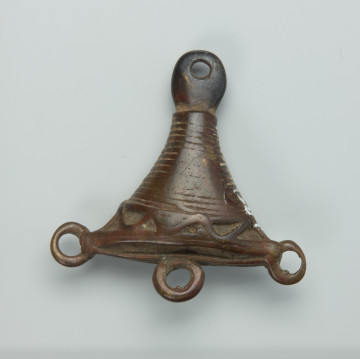
Headrest
między 1001 — 1300
National Museum in Szczecin
Part of the collection: Collection of Dogonian art
The Tellem bolster, indigenous people living in Bandiagara Escarpment (south-central part of the Republic of Mali) before the arrival of the Dogon used the presented. It was used as a home furnishing for resting and sleeping - the back of the head or the neck was placed on the upper part of the bolster resembling a flat wooden crescent. The Tellem people used bolster also in burial rites. Men used the object in question. The word tellem in the Dogoso language means ‘a man who was here before us’. The Dogon believe that when they left their ancestral homeland and came to the present area of the Bandiagara Escarpment, they encountered a group of people they called the Tellem. They then forced them to abandon their settlements and move to where is now Burkina Faso. The existence of the Tellem and their culture was confirmed during archaeological research conducted by Rogier M.A. Bedaux, a Dutch archaeologist, in the 1960s. During the excavations, caves located above the Dogon villages were examined. It was confirmed that the Tellem people inhabited present-day Dogon country in the 11th to 15th centuries. Based on the data collected, the archaeologists concluded that it was implausible that they were the ancestors of the Dogon or the peoples of Burkina Faso. During the research, it was found that the caves were not used as dwellings by the Tellem people. They built granaries to store food in some of them, while others were used as burial sites for their ancestors. Among the artefacts found by archaeologists, headstones from the 11th - 13th centuries stand out. These are the oldest wooden objects in the whole of West Africa. They have only been found in a few burial caves, so it is believed that they may have been a sign of the high social status of the deceased.
Katarzyna Findlik-Gawron
Author / creator
Dimensions
cały obiekt: height: 14,2 cm, width: 19,2 cm
Object type
sculpture
Creation time / dating
Creation / finding place
Identification number
Location / status

między 1001 — 1300
National Museum in Szczecin

między 1001 — 1300
National Museum in Szczecin

między 1201 — 1500
National Museum in Szczecin
DISCOVER this TOPIC
National Museum in Szczecin
DISCOVER this PATH
Educational path